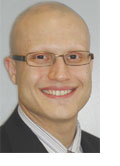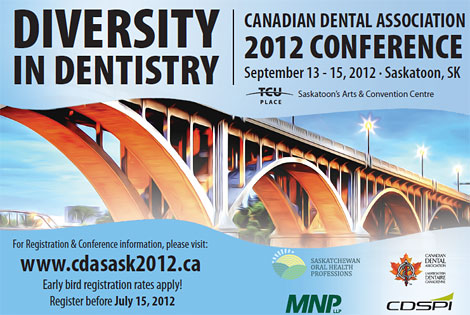
A member service that keeps you up-to-date on important new literature relevant to your practice.

|
|
Welcome to JCDA Express for 2012!
In this year's first installment, members of the JCDA community of expertise bring forward their recommendations of 4 articles in the field of pediatric dentistry.
The featured articles focus on Hawley orthodontic retainers, the effectiveness of topical fluorides, sleep-disordered breathing in children, and UK guidelines on stainless steel crowns for primary molars.
JCDA would like to gratefully acknowledge the publishers of the selected articles, who have granted free access to the full-text papers until April 2, 2012. Follow the links in the Notes and News sidebar to discover more about these publications.
JCDA Express strives to be a viable source of credible, up-to-date and clinically significant information. As a new innovation for 2012, we will also be featuring seminal articles in the dental literature that our experts deem to be just as relevant today as they were when originally published.
Finally, 2012 will be an exciting year for our new JCDA-OASIS project. We are currently looking for volunteers to provide input on short, 3-minute consultations on drug interactions and dental emergencies. We are also creating panels of experts that have medical or pharmacy degrees. Perhaps some dentists have spouses, relatives or acquaintances who might be willing to offer their expertise with our medical-related and prescription drug consults. If either of these scenarios sounds interesting, please contact me by phone or email.
Sincerely,
Dr. John P. O'Keefe
Editor-in-chief
1-800-267-6354, ext. 2297
jokeefe@cda-adc.ca
|
|
|



|
|
|

Hawley orthodontic retainers
Dr. James Noble is staff orthodontist at Holland Bloorview Kids Rehabilitation Hospital in Toronto; he also maintains a private orthodontic practice in Toronto. Dr. Noble recommends:
Shawesh M, Bhatti B, Usmani T, Mandall N. Hawley retainers full- or part-time? A randomized clinical trial. Eur J Orthod. 2010;32(2):165-70.
Full-text access to this article has expired.
JCDA Clinical Pearl: It is clinically acceptable for orthodontic patients to wear Hawley retainers only at night.
Key points:
-
This randomized clinical trial compared 2 orthodontic retention regimens in 67 patients: nighttime-only wear of an upper and lower Hawley retainer for 1 year vs. 6 months full-time wear followed by 6 months nighttime-only wear.
-
Study models were taken at the start and end of treatment and 1 year post-debond. Digital calipers were used to measure upper and lower labial segment irregularity (using Little's irregularity index) and upper and lower labial segment crowding; t tests were used to evaluate differences between each group.
-
There were no statistically significant differences between the 2 retention regimens at 1 year post-debond for labial segment irregularity or crowding
(p > 0.05).
-
Because both retention regimens were equally effective during the 1-year retention period, it would seem clinically acceptable to have patients wear retainers at nighttime only.
Reasons for recommending this article:
Retention protocols used by orthodontists can vary greatly, yet there is little evidence comparing post-treatment tooth movement and stability. This well-designed and executed study demonstrates that there is no difference in relapse with wearing Hawley retainers full time compared to nighttime only.
Wearing Hawley retainers during the day can be cumbersome for patients because speech is difficult, more effort is required to maintain oral hygiene, the labial bow of the Hawley is visible to others, and there is a greater chance that it will be lost. Based on the study results, it therefore seems reasonable to advise orthodontic patients to wear Hawley retainers at nighttime only. However, the authors warn clinicians not to extrapolate the findings of this study to vacuum-formed retainers.
|
|

|
|
|

Effectiveness of topical fluorides
Dr. Alyssa Hayes is a resident of the graduate dental public health program at the University of Toronto.
Dr. Carlos Quiñonez is director of the dental public health program at the University of Toronto and a member of CDA's Committee on Clinical and Scientific Affairs.
Drs. Hayes and Quiñonez recommend:
Marinho VCC. Evidence-based effectiveness of topical fluorides. Adv Dent Res. 2008;20(1):3-7.
Full-text access to this article has expired.
JCDA Clinical Pearl: All topical fluoride modalities (fluoridated toothpaste, mouthrinses, gels and varnish) are effective in reducing caries in children and adolescents. Further reductions are achieved when toothpaste is used in combination with other methods and when the concentration and frequency of application is increased.
Key points:
-
This article synthesizes a large body of knowledge by presenting the findings of 7 Cochrane systematic reviews on topical fluorides (> 65,000 children and adolescents in over 130 controlled trials).
-
All 4 topical fluoride modalities (fluoridated toothpaste, mouthrinses, gels and varnish) were effective, regardless of exposure to community water fluoridation.
-
The prevented fractions (i.e., percentage caries reduction) were 24% (fluoridated toothpaste), 26% (mouthrinses), 28% (gels) and 46% (varnish).
-
Fluoridated toothpastes represent the most readily available and most accepted modality among young people.
-
Treatment effect was larger among children with higher initial caries levels, and when frequency or concentration of the application was increased.
Reasons for recommending this article:
The 7 Cochrane reviews summarized in this article represent the highest level of evidence available and are considered the gold standard in decision making. The evidence supporting the use of topical fluorides is presented in terms of a single outcome measure (prevented fraction), allowing for a valid comparison between modalities. The caries reduction levels highlight the importance of using topical fluoride modalities in prevention programs and clinical practice.
|
|
 |
|
|

Sleep-disordered breathing in children
Dr. Fernanda Almeida is an assistant professor in orthodontics and pediatric dentistry at the University of British Columbia. Dr. Almeida recommends:
Huynh NT, Morton PD, Rompré PH, Papadakis A, Remise C. Associations between sleep-disordered breathing symptoms and facial and dental morphometry, assessed with screening examinations. Am J Orthod Dentofacial Orthop. 2011;140(6):762-70.
Full-text access to this article has expired.
JCDA Clinical Pearl: Dentists can play an important role in the detection of anatomical risk factors and symptoms of sleep-disordered breathing in healthy pediatric patients.
Key points:
-
This article aims to evaluate the prevalence of pediatric sleep-disordered breathing (SDB) symptoms and their association with craniofacial morphology.
-
Pediatric SDB symptoms are associated with adenotonsillar hypertrophy, a long and narrow face (dolichofacial, high mandibular plane angle, narrow palate, severe crowding of the maxilla and mandible), allergies, frequent colds and habitual mouth breathing.
-
This study looked at the characteristics of a general pediatric population (rather than sick children) treated in a university-based orthodontic clinic. The sample of patients is likely quite similar to the patient pool of many clinicians, making this article applicable and valuable for clinicians.
-
The article is well-written and the limitations regarding sample size and quality have been critically addressed. SDB is an emerging area of study and this paper is an important complement to the literature.
Reasons for recommending this article:
The field of pediatric sleep disorders and the role of dentists are not yet defined. Currently, most dental practices do not screen, evaluate or treat SDB. However, dentists are displaying a growing desire for knowledge in this area. Pediatric patient care will be improved when more clinicians are aware of the potential signs and symptoms of SDB (and their associated craniofacial characteristics) that may be present in their general practice patients. With this knowledge, dentists can help physicians identify SDB in young patients. Even though there is a relative shortage of evidence on the efficacy of orthodontic therapy for the treatment for SDB, management of these patients may involve an orthodontist and a pediatric respirologist, and specific treatment approaches can be explored accordingly.
|
|
|
|


Guidelines on stainless steel crowns for primary molars
Dr. Jennifer MacLellan is an assistant professor in pediatric dentistry at Dalhousie University and a staff pediatric dentist at the IWK Health Centre in Halifax, Nova Scotia. Dr. MacLellan recommends:
Kindelan SA, Day P, Nichol R, Willmott N, Fayle SA; British Society of Paediatric Dentistry. UK National Clinical Guidelines in Paediatric Dentistry: stainless steel preformed crowns for primary molars. Int J Paediatr Dent. 2008;18 Suppl 1:20-8.
Full-text access to this article has expired.
JCDA Clinical Pearl: Stainless steel crowns show superior longevity and durability when compared to amalgam, glass ionomer and composite resin restorations in the studies examined in this article.
Key points:
-
This article provides a concise review of the literature used to develop clinical guidelines in the UK on the use of stainless steel crowns (SSCs) on primary molars.
-
Although the vast majority of studies are retrospective in nature, this should not be interpreted as a lack of evidence on the efficacy of this treatment modality.
-
There are many indications for the placement of SSCs and preformed metal crowns, but relatively few contraindications.
-
SSCs are considered the restoration of choice for primary molars with caries on 2 surfaces (or on 1 surface where the carious lesions are extensive) and following pulp therapy.
-
SSCs should be strongly considered when treating molars with developmental defects, attrition or decalcified lesions and when treatment is provided under general anesthesia or for patients with special needs.
-
Despite evidence supporting the longevity of SSCs, the majority of general dentists do not employ this technique due to a lack of clinical experience.
Reasons for recommending this article:
Unable to find more recent articles on this topic, I felt that the classic literature supporting the continued use of SSCs and preformed crowns might be of interest to colleagues. This particular article provides a clear overview of indications, contraindications, and preparation and placement techniques for SSCs. Similar recommendations can also be found in guidelines from the American Academy of Pediatric Dentistry (also adopted by the Canadian Academy of Pediatric Dentistry).
Although we were all exposed to SSC preparation in dental school, the use of this technique by general dentists is reportedly very low. However, the technique is no more complex than Class II intracoronal restorations and can still be considered the restoration of choice in many clinical situations. Despite a limited number of studies published on the topic, I would caution against using the Hall technique as an alternative to standard crown preparation and placement.
I would also recommend 3 classic articles by Messer and Levering that outline the longevity of SSCs based upon age of placement and in comparison with intracoronal restorations.
Related resources:
-
Levering NJ, Messer LB. The durability of primary molar restorations: I. Observations and predictions of success of amalgams. Pediatr Dent. 1988;10(2):74-80.
-
Messer LB, Levering NJ. The durability of primary molar restorations: II. Observations and predictions of success of stainless steel crowns. Pediatr Dent. 1988;10(2):81-5.
-
Levering NJ, Messer LB. The durability of primary molar restorations: III. Costs associated with placement and replacement. Pediatr Dent. 1988;10(2):86-93.
|


|
|
|
|
|

JCDA is the authoritative written voice of the Canadian Dental Association, providing dialogue between the national association and the dental community. It is dedicated to publishing worthy scientific and clinical articles and informing dentists of issues significant to the profession.

|
|
|



